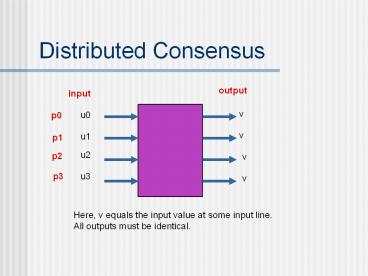Distributed Consensus PowerPoint PPT Presentation
1 / 20
Title: Distributed Consensus
1
Distributed Consensus
output
input
v
u0
p0
v
u1
p1
u2
p2
v
u3
p3
v
Here, v equals the input value at some input
line. All outputs must be identical.
2
Problem Specification
- Termination. Every non-faulty process must
eventually decide. - Agreement. The final decision of every non-faulty
process must be identical. - Validity. If every non-faulty process begins
with the same initial value v, then their final
decision must be v.
3
Asynchronous Consensus
- Seven members of a busy household decided to hire
a cook, since they do not have time to prepare
their own food. - Each member of the household separately
interviewed every applicant for the cooks
position. Depending on how it went, each member
formed his or her independent opinion "yes"
(means hire) or "no" (means don't hire). - These members will now have to communicate with
one another to reach a uniform final decision
about whether the applicant will be hired. - The process will be repeated with the next
applicant, until someone is hired.
4
Asynchronous Consensus
- Consider various modes of communication,
- like message passing or shared memory.
- If there is no failure, then collect all inputs
- and apply a decision function on the bag
- of inputs. Easy!
5
Asynchronous Consensus
- Theorem. In a purely asynchronous distributed
- system consensus problem is impossible
- to solve if even a single process crashes
- Famous result due to Fischer, Lynch, Patterson
- (commonly known as FLP 85)
6
Proof.
- Bivalent and Univalent states.
- A decision state is bivalent, if starting from
- that state, there exist two distinct executions
- leading to two distinct decision values 0 or 1.
- Otherwise it is univalent.
- A univalent state may be 0-valent or 1-valent.
7
Proof.
- Lemma. No execution can lead from a 0-valent to
a 1-valent state or vice versa. - Proof. Follows from the definition of 0-valent
and 1-valent states.
8
Proof.
- Lemma. Every consensus protocol must have a
bivalent initial state. - Proof by contradiction. Suppose not. Then
consider the following scenario - S0 0 0 0 0 0 0 0 0 0 0-valent)
- 0 0 0 0 0 0 0 0 1 sj is 0-valent
- 0 0 0 0 0 0 0 1 1 sj1 is 1-valent
- (differ in jth position)
- Sn-1 1 1 1 1 1 1 1 1 1 1-valent
What if process (j1) crashes at the first step?
9
Proof.
- Lemma.
- In a consensus protocol, starting from any
initial bivalent state I, there must exist a
reachable bivalent state T, such that every
action taken by some process p in state T leads
to either a 0-valent or a 1-valent state.
Actions 0 and 1 from T must be taken by the same
process p. Why?
10
Proof.
Case 1.
1-valent
e1
Decision 1
T1
q writes
T
Decision 0
p reads
T0
e0
0-valent
Case 1. Let e1 be a computation that excludes any
step by p. Case 2. Let p crash after
reading.Then e1 is a valid computation from T0
too. To all non-faulty processes, these two
computations are identical, but the outcomes are
different!
11
Proof.
Case 2
1-valent
e1
Decision 1
T1
q writes
T
Decision 0
p writes
T0
e0
0-valent
Both write on the same variable, and p writes
first. Case 1. Let e1 be a computation that
excludes any step by p. Case 2. Let p crash after
writing.Then e1 is a valid computation from T0
too. To all non-faulty processes, these two
computations are identical, but the outcomes are
different!
12
Proof.
Case 3
1-valent
Decision 1
T1
q writes
p writes
Z
T
q writes
Decision 0
p writes
T0
0-valent
Let p and q write on different variables. Then
regardless of the order of these writes, both
computations lead to the same global state Z. Is
Z 1-valent or 0-valent?
13
Proof.
- Thus p, q cannot be distinct processes, and p
q. p is known as the decider process. - What if p crashes in state T? No consensus is
reached!
14
Conclusion
- In a purely asynchronous system, there is no
solution to the consensus problem using a
deterministic algorithm. - Randomized algorithms exist for this problem.
- Or else, use the synchronous model.
15
Byzantine Generals Problem
- Describes and solves a consensus problem on the
synchronous model of communication. Processor
speeds have lower bounds and communication delays
have upper bounds.
16
Byzantine Generals Problem
- n generals 0, 1, 2, ..., n-1 decide about
whether to "attack" or to "retreat" during a
particular phase of a war. The goal is to agree
upon the same plan of action. - Some generals may be "traitors" and therefore
send either no value, or send conflicting values
of decisions to prevent the "loyal" generals from
reaching an agreement. - Devise a strategy, by which every loyal general
eventually agrees upon the same plan, regardless
of the action of the traitors.
17
Byzantine Generals
Attack 1
Attack1
0
1
completely connected graph
1, 1, 0, 0
3
2
Retreat 0
Retreat 0
18
Byzantine Generals
But no one knows who the traitor is. If there
are no traitors, then reaching agreement is
trivial
1
traitor
1
0
19
Byzantine Generals
We need to devise a protocol so that every
peer (call it a lieutenant) receives the same
value from any given general (call it a
commander). Clearly, the lieutenants will have
to use secondary information.
Note that the role of the commander and the
lieutenants will rotate among the generals.
20
Interactive consistency specifications
- IC1. Every loyal lieutenant receives
- the same order from the commander.
- IC2. If the commander is loyal, then
- every loyal lieutenant receives
- the order that the commander
- sends.

